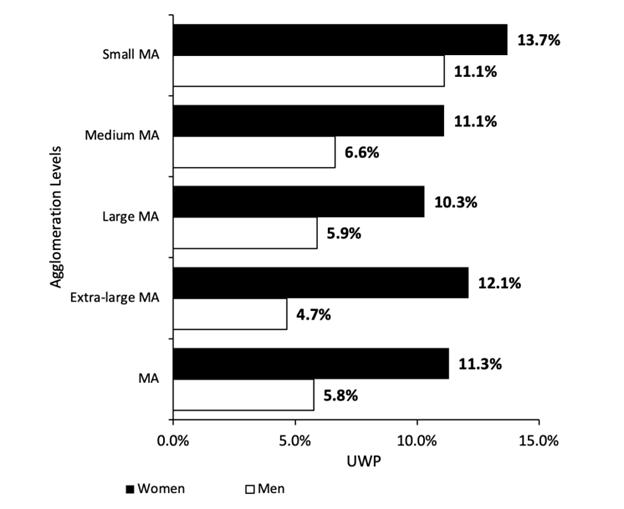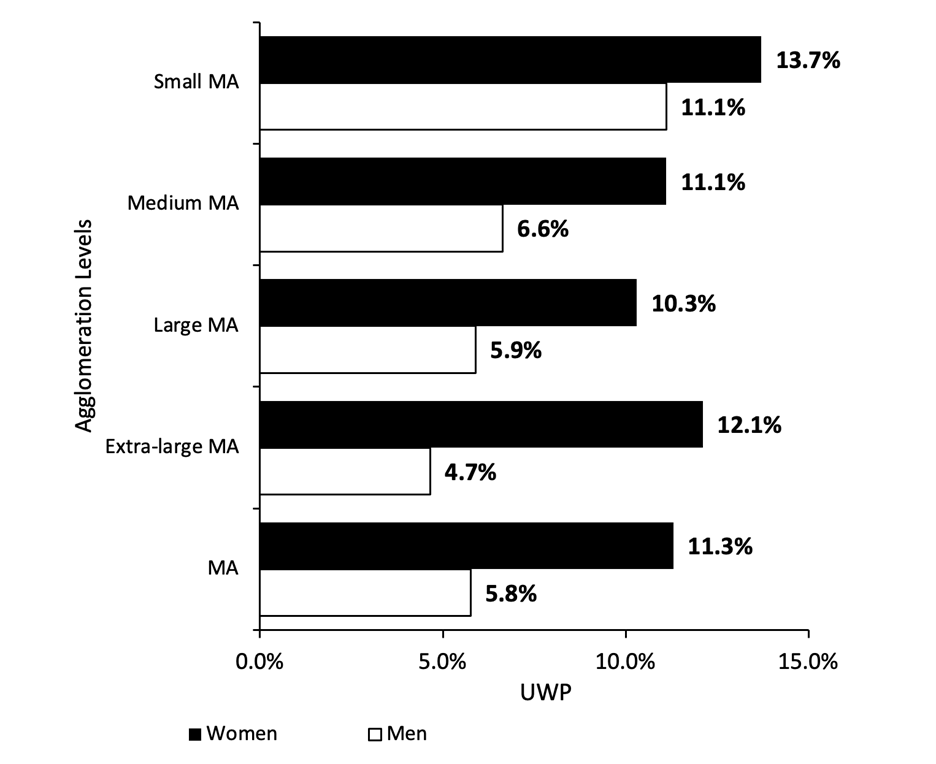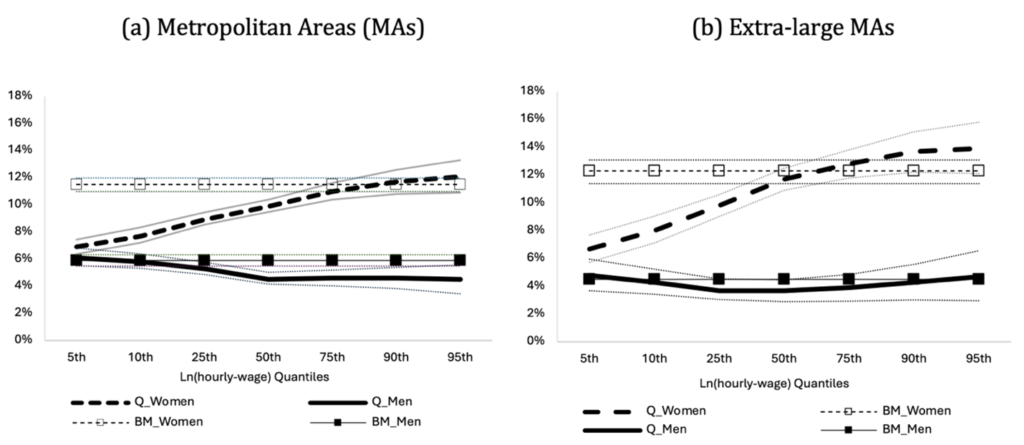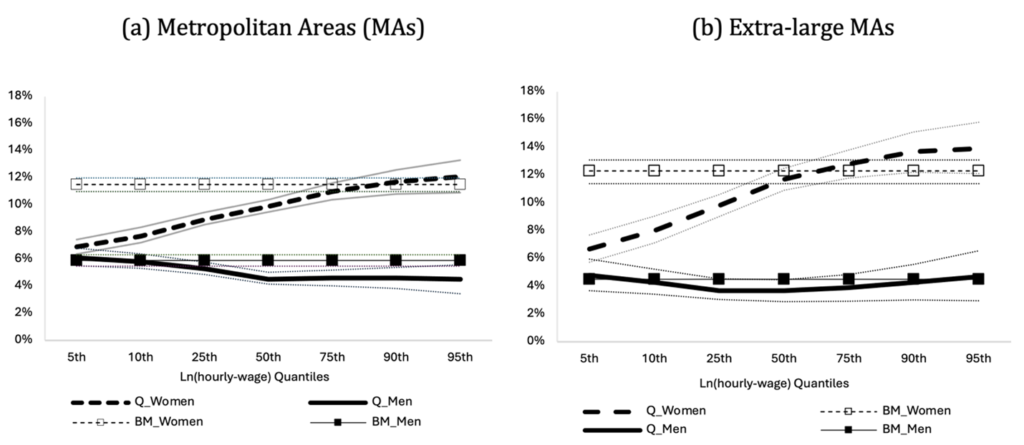September 10, 2024 – SOLANGE GONÇALVES AND ELOIZA ALMEIDA
Previously published on VoxEU on September 5, 2024.
The urban wage premium – the positive wage differential between more and less dense geographic areas – is rarely estimated separately for men and women. This column shows that, in Brazil, agglomeration economies benefit men and women differently in dense areas: the urban wage premiums for men and women change across the wage distribution and differ between formal and informal jobs. Studies focusing only on men may underestimate the premium.
The urban wage premium (UWP) is the positive wage differential between more and less dense geographic areas. Several national and international studies confirm this differential even after controlling for the characteristics of individuals, occupations, and firms (e.g. Combes et al. 2008, D’Costa and Overman 2014, Glaeser and Mare 2001, Chauvin et al. 2017). Despite advances in estimating the UWP, most studies focus on men in formal jobs. Precisely because these gendered differences in participation, wages, and labour market decisions exist, UWP analyses must include and distinguish women.
In our paper (Almeida et al. 2022), we estimate the female UWP using a comprehensive Brazilian labour market database. We investigate whether agglomeration economies in denser areas benefit men and women differently and whether female and male UWPs change along the wage distribution.
Our main result is that the female UWP, at 11.3%, is almost double the male UWP of 5.76%. The fact that women have a higher UWP is not new; historical data show that this trend has existed over the last 30 years in Brazil. Additionally, we find higher UWPs for women in various subgroups based on labour market formality and agglomeration levels. These results remain robust after controlling for selection bias related to labour market participation, which is particularly relevant for female workers.
The few empirical studies on female UWP report mixed results. Meekes and Hassink (2018) find no relevant difference between male and female UWPs in the Netherlands, while Jones et al. (2017) identify a UWP only for men in three African labour markets (Nigeria, Tanzania, and Uganda). 1 On the other hand, Nisic (2017), Duranton (2016), D’Costa and Overman (2014), and Phimister (2005) find a higher UWP for women, with variations in magnitude depending on the country and sub-sample of male and female workers.
The conclusion is that previous UWP results are likely underestimates since female workers are often neglected in most traditional UWP literature. Moreover, UWP may be over or underestimated for both women and men if the wage distribution is disregarded. We contribute to the scarce literature that estimates the UWP for women and men by using quantile regressions, an innovative way to explore whether agglomeration effects differently benefit both genders. Quantile regressions have rarely been applied in UWP studies (e.g. Matano and Naticchioni 2016, Cruz and Naticchioni 2012) and none has analysed female UWPs. Because women are often concentrated in unskilled and low-wage occupations, investigating the UWP across the wage distribution enhances existing interpretations of the UWP.
Estimating the UWP by gender
We focus on Brazilian Metropolitan Areas (MAs) and use data from the Continuous Brazilian National Household Sample Survey (PNADC) conducted between 2012 and 2019. The PNADC is a longitudinal database that provides detailed individual information about labour market transitions, as well as the characteristics of the occupations and firms where workers are employed. 2The female UWP reached 11.3%, while the male UWP is approximately half of the female UWP at 5.76%.
The higher differential in the female UWP compared to the male UWP observed in our study is new; existing studies report relatively small gaps between UWPs across genders. To elucidate the impact of this significant gender difference in the UWP, we assess its additional effect on average wages. In non-MAs, men have an average hourly wage of R$ 11.1, while women earn an average of R$ 9.4 per hour, resulting in a wage gap of 15.3% in favour of men. Adding the respective UWPs in each group shows that men’s average wage increases to R$ 12.7 per hour in MAs and women’s average salary to R$ 12.1, reducing the wage gap to 5.1%. Although this still favours men, this reduction may indicate that the UWP could serve as a mechanism to narrow the gender wage gap.
Given the heterogeneity of Brazilian MAs, we also estimate the UWP by considering the agglomeration levels of four groups of MAs by size. The female UWP ranges between 10.3% and 13.7% and is higher in the two extreme settings, namely, in small and extra-large MAs. Men demonstrate an UWP between 4.66% and 11.1%, which decreases as density increases. The main results hold, with the female UWP surpassing the male UWP across all agglomeration levels.
Evidence across the wage distribution
The average UWP hides important heterogeneity that exists across the wage distribution. Quantile regressions allow us to estimate the UWP throughout the wage distribution. The female UWP is lower at the beginning of the distribution, starting close to the male UWP – at around 7% – but it increases and exceeds 12% in groups with higher salaries (90th and 95th quantiles). Highly paid jobs benefit from a higher premium in denser areas – especially in extra-large MAs – so the position in the wage distribution also affects the magnitude of the female UWP. This suggests that, in denser MAs, women in highly paid jobs may benefit more from agglomeration effects than women in low-productivity and low-paid jobs.
Figure 1 Urban wage premium estimation for Metropolitan and agglomeration levels


Notes: The figure shows the estimated UWP for each agglomeration level and all Metropolitan Areas, by gender. Female UWP surpasses male UWP across all agglomeration levels.
Source: Almeida et al. (2022).
Figure 2 UWP estimation using quantile regressions


Notes: The figure shows the estimated UWP for Metropolitan Areas (a) and Extra-large MAs (b), by gender across the wage distribution. The vertical axis denotes the UWP magnitude. Gray lines indicate a 95% confidence interval. The base Model considers only the first interview for each individual in the sample.
Source: Almeida et al. (2022).
Possible mechanisms and implications
A variety of channels may contribute to gendered differences in the UWP. Some mechanisms may lead to a higher UWP for women than for men, such as city infrastructure, public services, and social protection measures that incentivise women to enter the labour market (Phimister 2005, Watt et al. 2021). Easily accessible childcare could potentially allow women with children to work full-time and access more competitive and demanding jobs. Moreover, women may benefit more from the greater diversity and the broader labour market of Metropolitan Areas, which facilitate better matching between firms and workers (Madden and Chiu 1990, Meekes and Hassink 2018).
Women may experience higher rates of career interruption, labour turnover, and job-to-job transition, as well as fewer working hours compared to men. The demand for more flexibility, part-time positions, and frequent career changes and interruptions could mean that women also benefit more from job matching in urban areas. Additionally, women in MAs more frequently work in white-collar jobs at large and highly productive companies that pay relatively well (Phimister 2005).
Another mechanism that may contribute to a higher female UWP is women’s concentration in service occupations, which could offer more flexibility and enable the combination of paid work and domestic activities. Krug and Nisic (2011) argue that although women comprise a larger proportion of the service sector than men, the structure and size of the service sector in dense areas can have positive effects, such as advancement to higher-paid positions.
On the other hand, a higher UWP may be expected for men because the more frequent career interruptions and labour turnover faced by women could affect their accumulation of human capital, implying potential life-cycle earnings losses. This effect may be more pronounced in MAs due to the learning process’s agglomeration effect (Phimister 2005). An in-depth investigation of the male and female UWP remains a relevant empirical issue.
We offer strong evidence that agglomeration effects do not benefit all workers equally. It appears that denser areas are more favourable for women, as they have a higher share of women in highly paid jobs. This scenario is consistent across different subgroups, indicating that agglomeration effects have overcome possible constraints such as women’s low spatial mobility, as noted in the literature.
This results offer a helpful perspective for discussions about gender wage differentials. First, denser areas appear to enjoy a greater awareness of the gender gap; therefore, a higher female UWP can contribute to closing the gap. However, a higher female UWP might also exacerbate existing inequalities between women in MAs and those in non-MAs, potentially disadvantaging women overall. From a policy perspective, this result suggests the need for different and coordinated actions across various agglomeration levels. This is particularly important for non-MAs, where the lack of agglomeration effects worsens labour market opportunities, especially for women.
Solange Gonçalves is an assistant professor at the University of São Paulo.
Eloiza Almeida is a Ph.D. candidate in Economic Theory at the University of São Paulo (FEA-USP).
References
Almeida, E R, V Araújo and S L Gonçalves (2022), “Urban wage premium for women: evidence across the wage distribution”, World Development 159: 106059.
Chauvin, J P, E Glaeser, Y Ma and K Tobio (2017), “What is different about urbanization in rich and poor countries? Cities in Brazil, China, India and the United States”, Journal of Urban Economics 98: 17–49.
Combes, P-P, G Duranton and L Gobillon (2008), “Spatial wage disparities: Sorting matters!”, Journal of Urban Economics 63: 723–742.
Cruz, B d O and P Naticchioni (2012), “Falling urban wage premium and inequality trends: evidence for Brazil,” Investigaciones regionales: Journal of Regional Research 126: 91–114.
D’Costa, S and H G Overman (2014), “The urban wage growth premium: sorting or learning?” Regional Science and Urban Economics 48: 168–179.
Duranton, G (2016), “Agglomeration effects in Colombia,” Journal of Regional Science 56: 210–238.
Glaeser, E L and D C Mare (2001), ”Cities and skills,” Journal of Labor Economics 19: 316–342.
Jones, P, O D’Aoust and L Bernard (2017), “The urban wage premium in Africa,” in Wage Inequality in Africa, Springer.
Krug, G and N Nisic (2011), “Is there an urban wage premium for women? A difference-in- difference analysis using Propensity Score Matching,” LASER Discussion Paper 54.
Madden, J F and L-i-C Chiu (1990), “The wage effects of residential location and commuting constraints on employed married women,” Urban Studies 27: 353–369.
Matano, A and P Naticchioni (2016), “What drives the urban wage premium? Evidence along the wage distribution,” Journal of Regional Science 56: 191–209.
Meekes, J and W H Hassink (2018), “Endogenous local labour markets, regional aggregation and agglomeration economies,” USE Working Paper series 18.
Nisic, N (2017), “Smaller differences in bigger cities? Assessing the regional dimension of the gender wage gap,” European Sociological Review 33: 292–3044.
Phimister, E (2005), “Urban effects on participation and wages: are there gender differences?,” Journal of Urban Economics 58: 513–536.
Watt, A, S Kelly, J Lawson and N Hardie (2021), “Boosting women’s labour-force participation to lift long-term growth,” VoxEU.org, 18 February.
Wooldridge, J M (2010), Econometric analysis of cross section and panel data, MIT press.
Footnotes
The same result is reported by Krug and Nisic (2011) for urban areas in Germany.
We estimate and correct the sample selection bias related to participation in the labour market, particularly relevant in female workers case, following Wooldridge (2010).
Photo by Vinícius Pimenta: https://www.pexels.com/photo/illuminated-city-at-night-311620/

0 Comments